Two-Stage Robust Economic Dispatch of Regional Integrated Energy System Considering Source-Load Uncertainty Based on Carbon Neutral Vision
Abstract
:1. Introduction
- (1)
- The uncertainties of wind power, photovoltaic output and multiple types of loads were considered, and a two-stage robust and optimized economic scheduling model was established with the goal of minimizing operation cost and regulation cost with day-ahead scheduling. First, the model was built taking into account the electrical, gas and thermal network characteristics of the RIES as well as energy conversion equipment, energy storage equipment and various composite characteristics. Considering the extreme cases of wind and photovoltaic power and load forecasting errors in day-ahead scheduling, the TRO model was constructed.
- (2)
- Combined with the strong duality theory, the column-and-constraint generation algorithm was used to transform the model into a mixed integer linear programming problem.
- (3)
- A regional integrated energy system in summer was taken as an example to verify the effectiveness of the model. The difference between the two-stage robust optimization model with the deterministic scheduling method and the worst case with different uncertain budget values was compared and analyzed. The results show that the two-stage robust economic optimization model can significantly improve the operating economy of the system.
2. Regional Integrated Energy System Structure
3. Regional Integrated Energy System Main Equipment Model
3.1. GAS Turbine Cogeneration Unit
3.2. Gas Boiler
3.3. Electric Boiler
3.4. Absorption Refrigeration
3.5. Electric Refrigeration
3.6. Heat Storage Equipment
3.7. Electric Energy Storage
3.8. Modeling of Uncertainties
4. Regional Integrated Energy System Two-Stage Robust Optimal Scheduling Model Considering Bilateral Uncertainties
4.1. The Objective Function
4.2. The Constraints
4.2.1. First Stage Constraints
4.2.2. Second Stage Constraints
5. Column-and-Constraint Generation Algorithm
6. Case
6.1. Optimization Results of Regional Integrated Energy System
6.2. Scenario Analysis
7. Conclusions
- (1)
- The cost of day-purchase deviation obtained by the two-stage robust optimization method is lower than that obtained by the deterministic optimization method, while the traditional scheduling method does not consider the uncertain factors in advance, resulting in a large day-purchase deviation. The total cost of two-stage robust optimal scheduling is better than that of traditional deterministic scheduling methods.
- (2)
- Through the multi-energy coupling device and multi-energy coordination joint optimization, the proposed day-ahead scheduling strategy can effectively cope with the source-charge uncertainty in the day-ahead scheduling stage and enhance the robustness of the system.
- (3)
- By adjusting the uncertain budget value, RIES operators can flexibly adjust the scheduling conservatism of the RIES, which provides a reference for RIES operators to weigh the robustness and economy of the system.
Author Contributions
Funding
Acknowledgments
Conflicts of Interest
Abbreviations
| RIES | Regional integrated energy system |
| BESS | Battery energy storage systems |
| DR | Demand response |
| TRO | Two-stage robust optimization |
| CCG | Column-and-constraint generation algorithm |
| SP | Subproblem |
| MP | Main problem |
References
- Zhang, S.; Wang, K.; Xu, W.; Lyer-Raniga, U.; Athienitis, A.; Ge, H.; woo Cho, D.; Feng, W.; Okumiya, M.; Yoon, G.; et al. Policy recommendations for the zero energy building promotion towards carbon neutral in Asia-Pacific Region. Energy Policy 2021, 159, 112661. [Google Scholar] [CrossRef]
- Song, S.; Li, T.; Liu, P.; Li, Z. The transition pathway of energy supply systems towards carbon neutrality based on a multi-regional energy infrastructure planning approach: A case study of China. Energy 2022, 1, 122037. [Google Scholar] [CrossRef]
- Wu, H.; Xue, Y.; Hao, Y.; Ren, S. How does internet development affect energy-saving and emission reduction? Evidence from China. Energy Econ. 2021, 11, 105577. [Google Scholar] [CrossRef]
- Miao, B.; Lin, J.; Li, H.; Liu, C.; Li, B.; Zhu, X.; Yang, J. Day-Ahead Energy Trading Strategy of Regional Integrated Energy System Considering Energy Cascade Utilization. IEEE Access 2020, 8, 138021–138035. [Google Scholar] [CrossRef]
- Kumar, R.S.; Raghav, L.P.; Raju, D.K.; Singh, A.R. Intelligent demand side management for optimal energy scheduling of grid connected microgrids. Appl. Energy 2021, 285, 116435. [Google Scholar] [CrossRef]
- Katiraei, F.; Iravani, R.; Hatziargyriou, N.; Dimeas, A. Microgrids management. IEEE Power Energy Mag. 2008, 6, 54–65. [Google Scholar] [CrossRef]
- Liu, X.; Li, N.; Liu, F.; Mu, H.; Li, L.; Liu, X. Optimal Design on Fossil-to-Renewable Energy Transition of Regional Integrated Energy Systems under CO2 Emission Abatement Control: A Case Study in Dalian, China. Energies 2021, 14, 2879. [Google Scholar] [CrossRef]
- Wang, Y.; Wang, J.; Liu, Z.; Liu, Y.; Tan, Z. Multi-objective synergy planning for regional integrated energy stations and networks considering energy interaction and equipment selection. Energy Convers. Manag. 2022, 1, 114986. [Google Scholar] [CrossRef]
- Wang, Y.; Jiang, C.; Wen, F.; Xue, Y.; Chen, F.; Zhang, L.; Yuan, X. Energy Trading and Management Strategies in a Regional Integrated Energy System with Multiple Energy Carriers and Renewable-Energy Generation. J. Energy Eng. 2021, 147, 04020076. [Google Scholar] [CrossRef]
- Li, X.; Wang, W.; Wang, H. A novel bi-level robust game model to optimize a regionally integrated energy system with large-scale centralized renewable-energy sources in Western China. Energy 2021, 8, 120513. [Google Scholar] [CrossRef]
- Song, X.; Long, Y.; Tan, Z.; Zhang, X.; Li, L. The optimization of distributed photovoltaic comprehensive ef ciency based on the construction of regional integrated energy management system in China. Sustainability 2016, 11, 1201. [Google Scholar] [CrossRef] [Green Version]
- Li, J.; Niu, D.; Wu, M.; Wang, Y.; Li, F.; Dong, H. Research on Battery Energy Storage as Backup Power in the Operation Optimization of a Regional Integrated Energy System. Energies 2018, 11, 2990. [Google Scholar] [CrossRef] [Green Version]
- Lei, Y.; Wang, D.; Jia, H.; Chen, J.; Li, J.; Song, Y.; Li, J. Multi-objective stochastic expansion planning based on multi-dimensional correlation scenario generation method for regional integrated energy system integrated renewable energy. Appl. Energy 2020, 10, 115395. [Google Scholar] [CrossRef]
- Wang, Y.; Huang, Y.; Wang, Y.; Zeng, M.; Yu, H.; Li, F.; Zhang, F. Optimal scheduling of the RIES considering time-based demand response programs with energy price. Energy 2018, 12, 733–793. [Google Scholar] [CrossRef]
- Zhao, D.; Xia, X.; Tao, R. Optimal Configuration of Electric-Gas-Thermal Multi-Energy Storage System for Regional Integrated Energy System. Energies 2019, 7, 2586. [Google Scholar] [CrossRef] [Green Version]
- Wang, J.; Li, P.; Fang, K.; Zhou, Y. Robust Optimization for Household Load Scheduling with Uncertain Parameters. Appl. Sci. 2018, 4, 575. [Google Scholar] [CrossRef] [Green Version]
- Liu, C.; Wang, X.; Guo, J.; Huang, M.; Wu, X. Chance-constrained scheduling model of grid-connected microgrid based on probabilistic and robust optimization. IET Gener. Transm. Distrib. 2018, 12, 2499–2509. [Google Scholar] [CrossRef]
- Zhong, J.; Wang, L.; Zhao, X.; Han, B. Research on optimisation of integrated energy system scheduling based on weak robust optimisation theory. IET Gener. Transm. Distrib. 2019, 13, 64–72. [Google Scholar]
- Kim, H.J.; Kim, M.K.; Lee, J.W. A two-stage stochastic p-robust optimal energy trading management in microgrid operation considering uncertainty with hybrid demand response. Int. J. Electr. Power Energy Syst. 2021, 1, 106422. [Google Scholar] [CrossRef]
- Wang, Y.; Tang, L.; Yang, Y.; Sun, W.; Zhao, H. A stochastic-robust coordinated optimization model for CCHP micro-grid considering multi-energy operation and power trading with electricity markets under uncertainties. Energy 2020, 198, 117273. [Google Scholar] [CrossRef]
- Moretti, L.; Martelli, E.; Manzolini, G. An efficient robust optimization model for the unit commitment and dispatch of multi-energy systems and microgrids. Appl. Energy 2020, 3, 113859. [Google Scholar] [CrossRef]
- Giraldo, J.S.; Castrillon, J.A.; L’opez, J.C.; Rider, M.J.; Castro, C.A. Microgrids energy management using robust convex programming. IEEE Trans. Smart Grid 2019, 10, 4520–4530. [Google Scholar] [CrossRef]
- Zhao, H.; Wang, Y.; Zhao, M.; Tan, Q.; Guo, S. Day-ahead market modeling for strategic wind power producers under robust market clearing. Energies 2017, 10, 924. [Google Scholar] [CrossRef] [Green Version]
- Zhu, J.; Huang, S.; Liu, Y.; Lei, H.; Sang, B. Optimal energy management for grid-connected microgrids via expected-scenario-oriented robust optimization. Energy 2021, 2, 119224. [Google Scholar] [CrossRef]
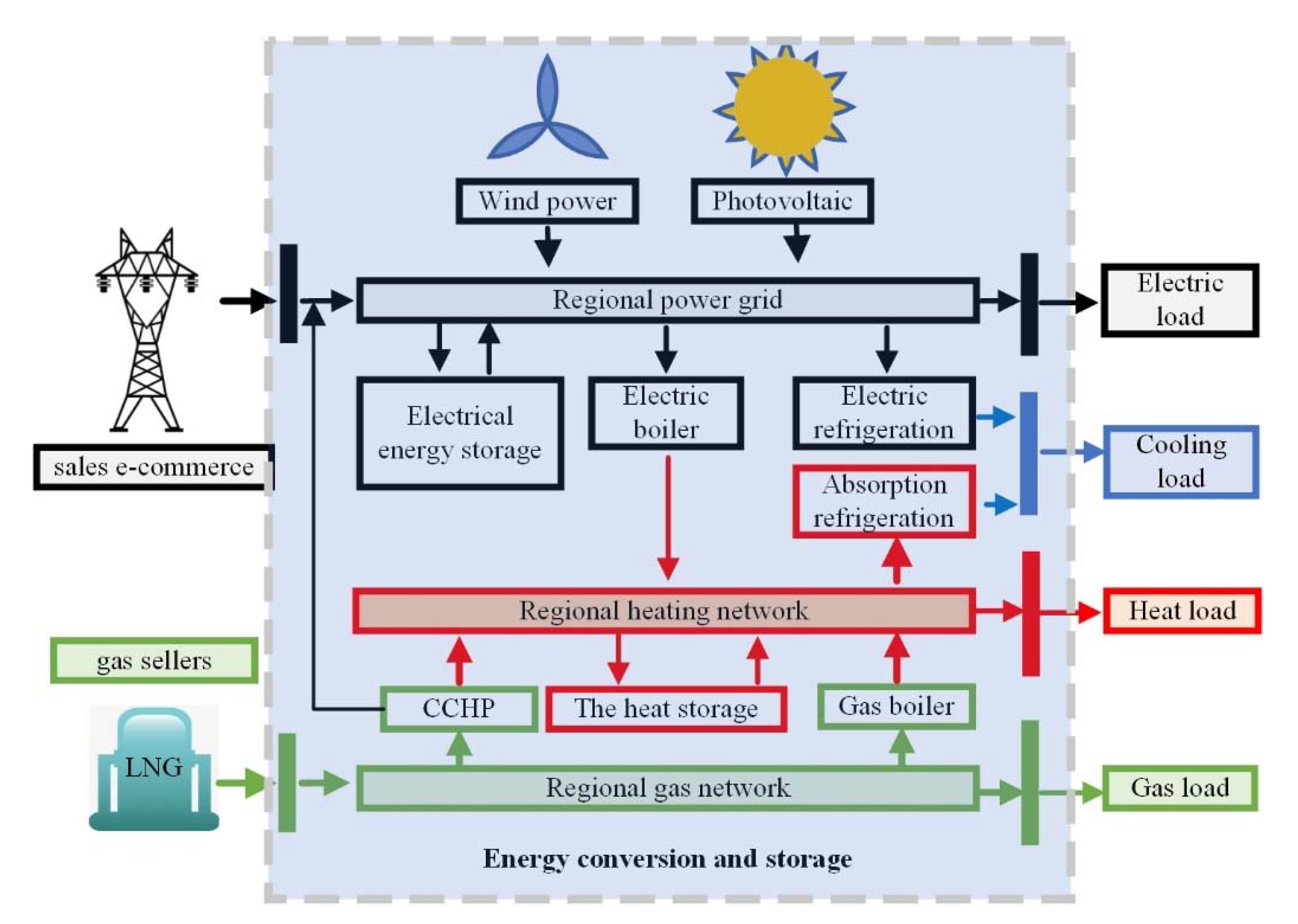
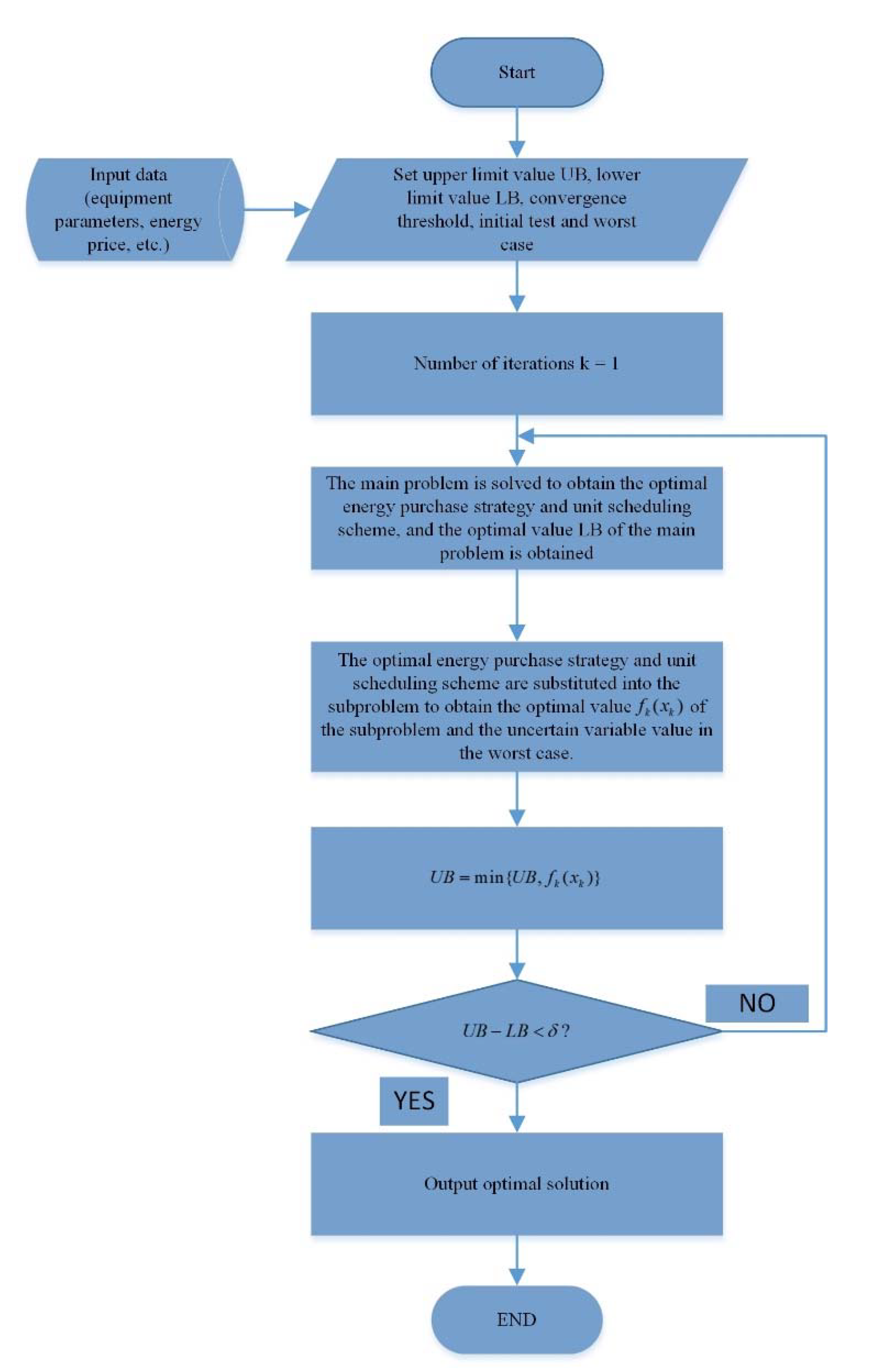
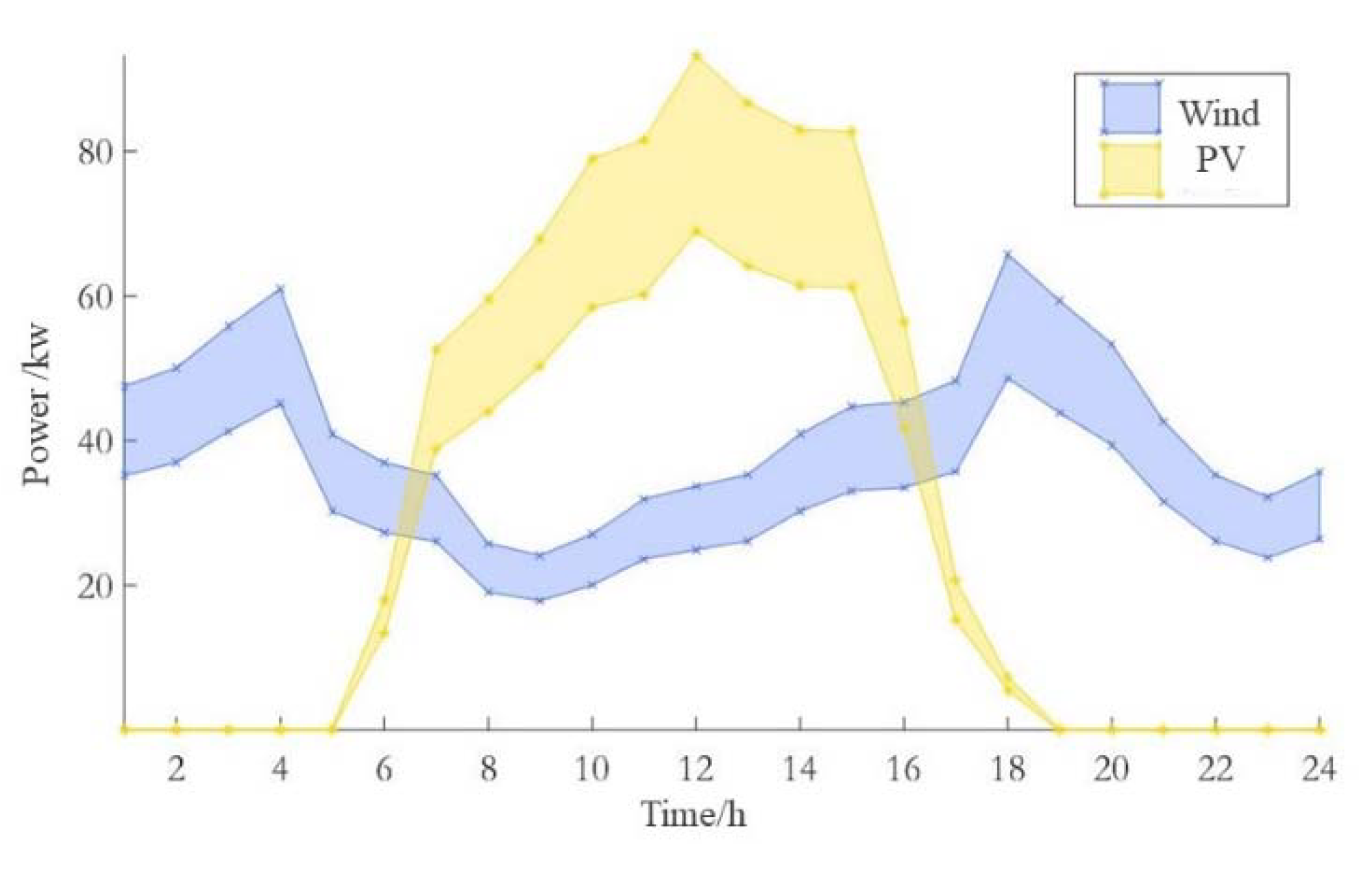
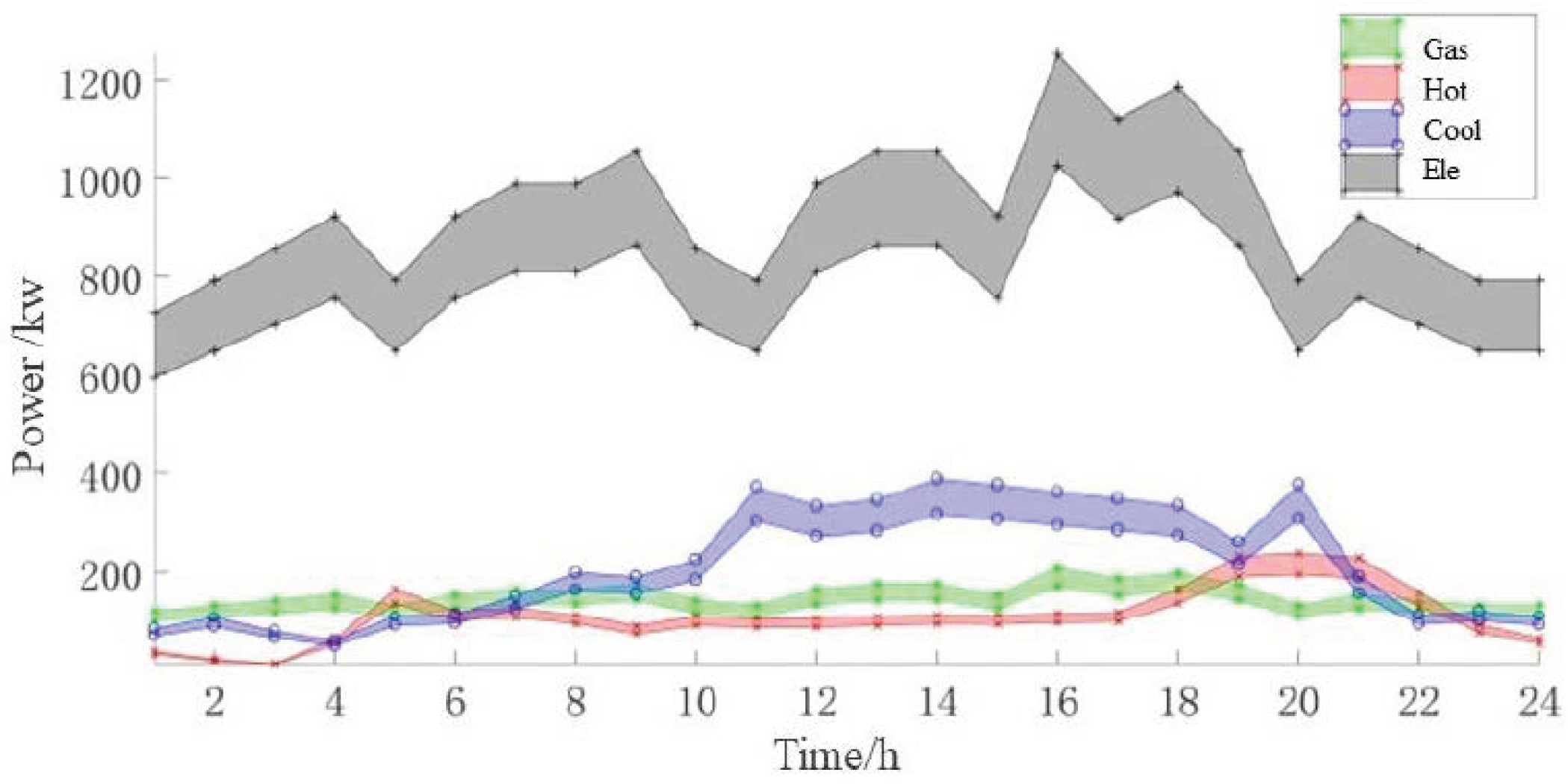
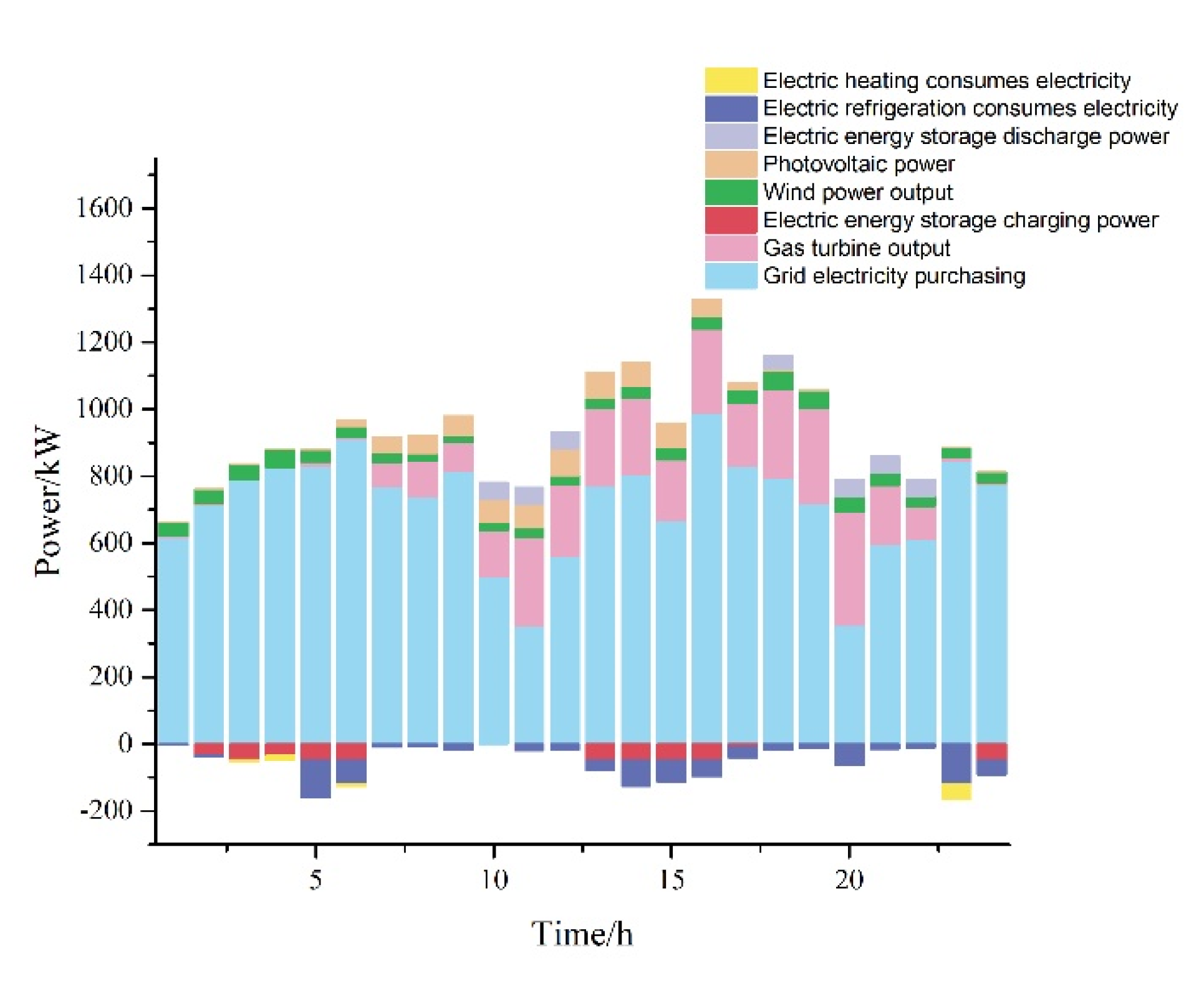
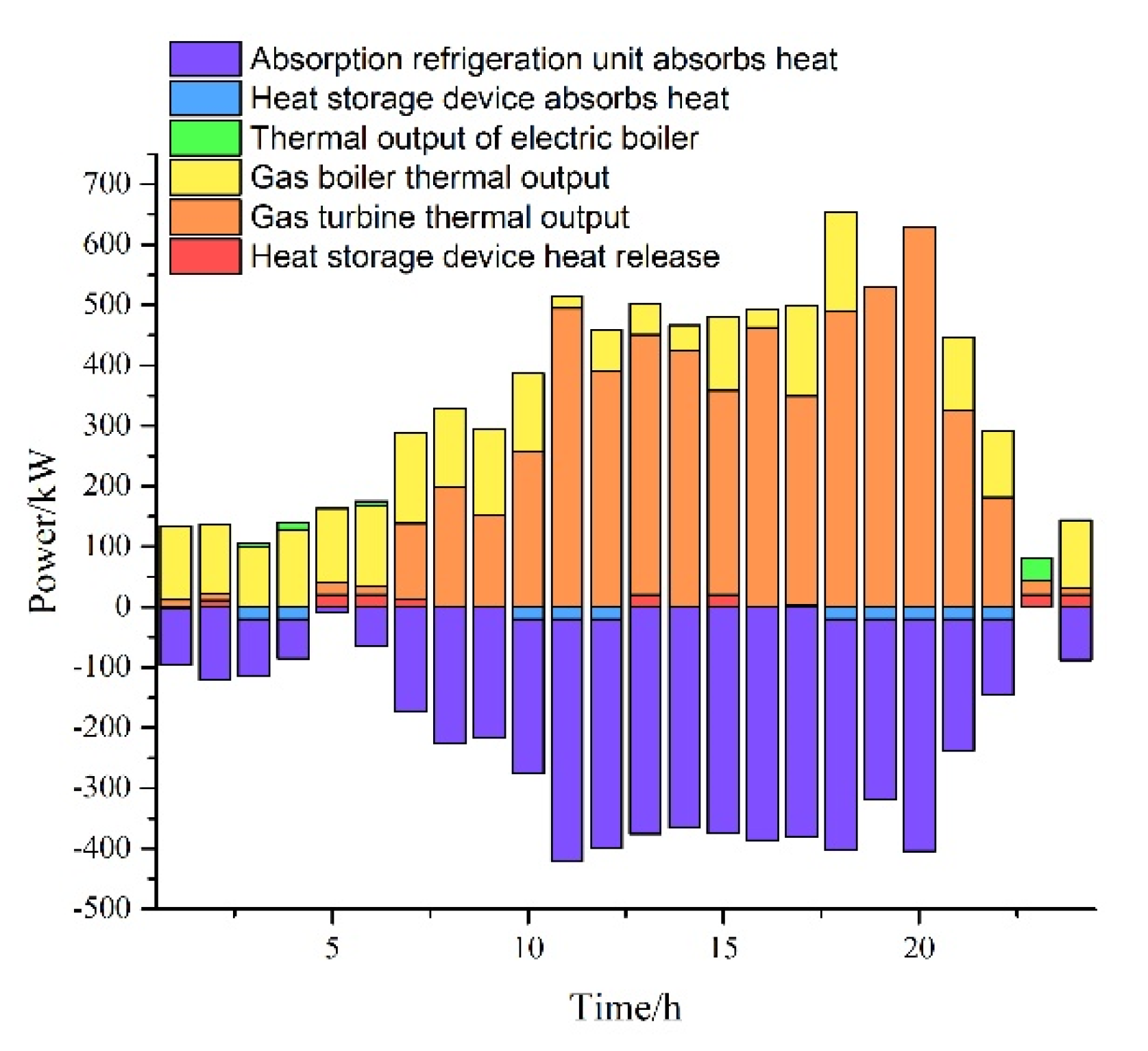
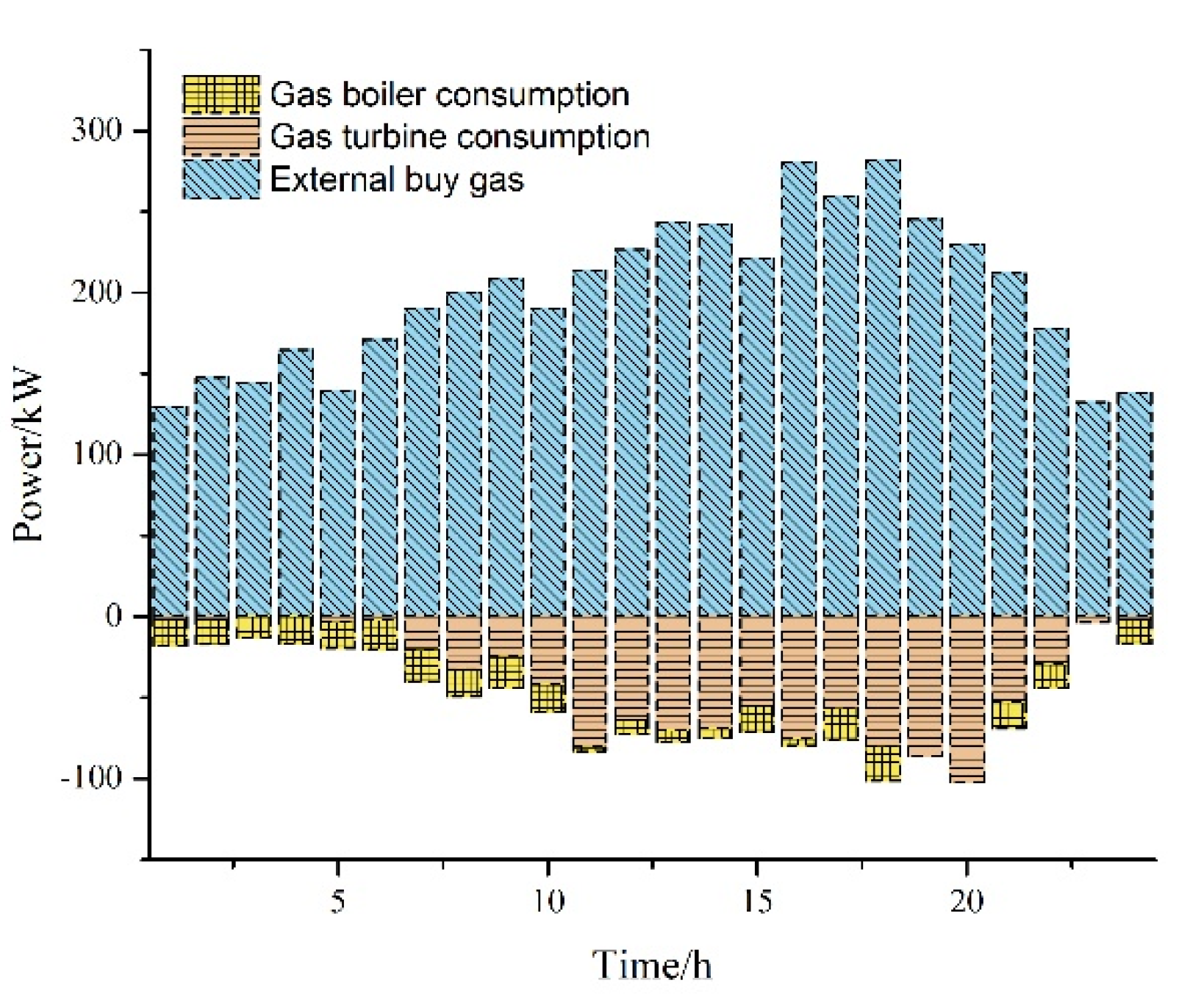
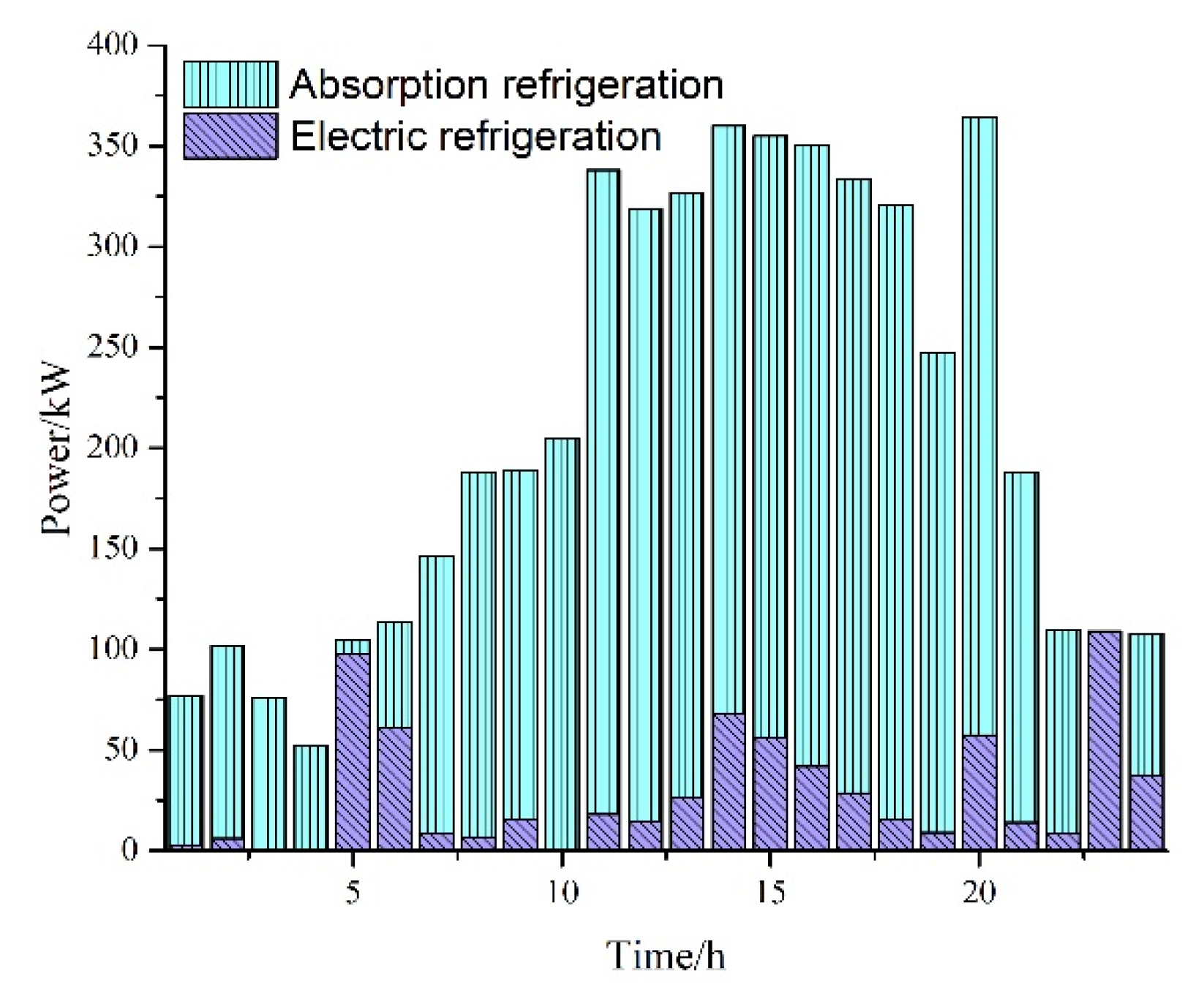
| Cost | Deterministic Optimization | Two-Stage Robust Optimization |
|---|---|---|
| Day-ahead dispatching cost | 22,844.74 | 23,622.95 |
| Cost of purchasing deviation | 3883.77 | 1176.57 |
| Total cost of electricity purchase | 26,728.51 | 24,799.52 |
| Cost | Scenario 1 | Scenario 2 | Scenario 3 | Scenario 4 |
|---|---|---|---|---|
| Power purchase cost | 8174.69 | 8172.63 | 9108.11 | 9079.98 |
| Purchase cost of gas | 14,670.04 | 14,630.47 | 14,585.10 | 14,542.97 |
| The total cost | 22,844.74 | 22,803.10 | 23,693.21 | 23,622.95 |
Publisher’s Note: MDPI stays neutral with regard to jurisdictional claims in published maps and institutional affiliations. |
© 2022 by the authors. Licensee MDPI, Basel, Switzerland. This article is an open access article distributed under the terms and conditions of the Creative Commons Attribution (CC BY) license (https://creativecommons.org/licenses/by/4.0/).
Share and Cite
Gao, J.; Yang, Y.; Gao, F.; Wu, H. Two-Stage Robust Economic Dispatch of Regional Integrated Energy System Considering Source-Load Uncertainty Based on Carbon Neutral Vision. Energies 2022, 15, 1596. https://doi.org/10.3390/en15041596
Gao J, Yang Y, Gao F, Wu H. Two-Stage Robust Economic Dispatch of Regional Integrated Energy System Considering Source-Load Uncertainty Based on Carbon Neutral Vision. Energies. 2022; 15(4):1596. https://doi.org/10.3390/en15041596
Chicago/Turabian StyleGao, Jianwei, Yu Yang, Fangjie Gao, and Haoyu Wu. 2022. "Two-Stage Robust Economic Dispatch of Regional Integrated Energy System Considering Source-Load Uncertainty Based on Carbon Neutral Vision" Energies 15, no. 4: 1596. https://doi.org/10.3390/en15041596
APA StyleGao, J., Yang, Y., Gao, F., & Wu, H. (2022). Two-Stage Robust Economic Dispatch of Regional Integrated Energy System Considering Source-Load Uncertainty Based on Carbon Neutral Vision. Energies, 15(4), 1596. https://doi.org/10.3390/en15041596





